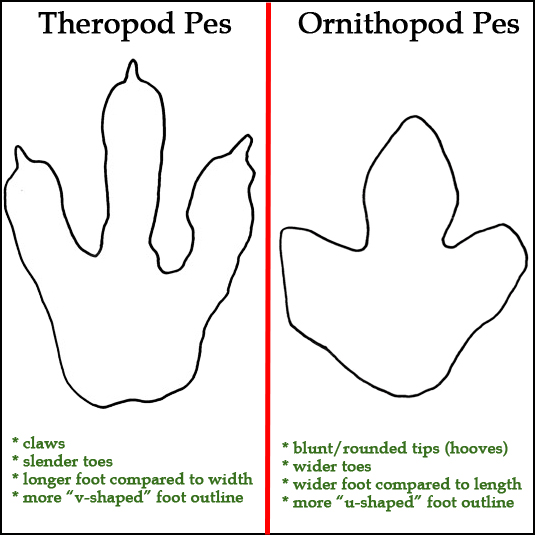The Wyoming, Isle of Skye Dinosaur Track Mystery
Dinosaur Tracks in Wyoming and the Isle of Skye
A joint British and American team of ichnologists are trying to unravel the mystery of sets of dinosaur footprints that look so similar that they may have been made by the same type of dinosaur. Trouble is one set of prints is in Wyoming the other tracks are to be found on the Scottish island of Skye, off the west coast of the United Kingdom.
Dinosaur Fossils
The three-toed tracks, indicating that they were made by a bipedal dinosaur, most probably a theropod, at the two locations look very similar but their resemblance may only be superficial and the American and British researchers intend to study them in more detail before making any specific pronouncements. Scientists who study fossilised footprints and trackways are called ichnologists. Footprints are an example of a trace fossil, they provide evidence of behaviour and unlike body fossils such as bones, they are “in situ”, meaning that a dinosaur actually walked over that area. Bones can often be transported long distances from where the animal actually lived to where they eventually become fossilised.
The trackways have been known about for sometime and the connection between the two track sites had been reported in the Scottish Journal of Geology back in 2008, but now the teams are going to employ sophisticated 3-D mapping techniques to gain as much data about the footprints as possible.
An article was written about the Wyoming and Scottish dinosaur tracks, previously to read more about the prints and to see the type of animal that may have made them:
Wyoming and Isle of Skye Footprints: Earlier Wyoming and Scottish Trackway Article.
The trackways are very important as little is known about Middle Jurassic Dinosauria. The dinosaurs were beginning to dominate life on land but the fossil record is particularly poor from rocks representing the Middle Jurassic (with the exception of sites such as Dashanpu quarry in China).
Studying Tracks
University of Glasgow (Scotland) palaeontologist Neil Clark who has studied both sets of 170-million-year- old tracks, admits that he has difficulty in finding any differences between the two sets of prints. This may indicate that they were made by the same type of dinosaur, one that lived in Scotland and also in Wyoming in the west of the USA.
Commenting on the trackways, he stated:
“The fact that the footprints in Wyoming and the ones in Scotland are so similar suggest that they may have been produced by a very similar kind of dinosaur, if not the same species”.
If it is proved beyond reasonable doubt that the same dinosaur species made the trackways, this would be unique in the fossil record, as no scientist has been able to say for certain that the same dinosaur species was responsible for fossil tracks discovered at separate locations, not to mention thousands of miles apart.
The American scientists intend to study both sets of tracks in much more detail using sophisticated computer based mapping technology. These will create three dimensional images that can be downloaded easily and shared between the scientists on different sides of the Atlantic.
Brent Breithaupt, a palaeontologist at the University of Wyoming and head of the school’s Geological Museum, commented:
“What we hope will eventually happen is that there will be this huge virtual archive that can be shared worldwide. Tracks can be looked at in three dimensions on computer screens and can be rotated around by various researchers and can be compared”.
However, he doubts the same dinosaur species made the Wyoming and Scottish prints:
“The tracks are similar, that’s what we know. It more than likely indicates similar types of dinosaurs living at higher latitudes at some point in time”.
Comparing Different Types of Dinosaur Tracks
Picture credit: Everything Dinosaur
The environments at the time, may have been similar and this would have enabled similar types of dinosaurs to exist, although the locations were very far apart.
Most of the tracks Neil Clark examined from the two locations ranged from about an inch long to more than 8 inches. He compared relative measurements including the length of each toe and angles between them. One set of tracks is from the area of Red Gulch, near the town of Shell in arid north-central Wyoming. The Scottish trackways are to be found on the shoreline on the west coast of the Isle of Skye.
Closer in the Middle Jurassic
The United States and Scotland were much closer together in the Middle Jurassic, the Atlantic ocean had not begun to separate Europe from the Americas, however, the tracks were approximately 2,500 miles apart when they were made, indicating that similar types of dinosaurs lived in what was to become Scotland and also in the western United States.
Breithaupt and geographer Neffra Matthews followed up Neil Clark’s visit to Red Gulch by travelling to the Scottish island. They photographed the tracks there and plan to process those photos into three-dimensional images so that they can be compared with the three-dimensional images of the Wyoming prints.
Matthews works for the U.S. Bureau of Land Management (BLM) in Denver and her speciality is using photogrammetry to document archaeological and palaeontological sites on BLM land. She has worked closely with Breithaupt at Red Gulch, hopefully this new study will provide a much more accurate analysis of the two sets of trackways.
Everything Dinosaur stocks a huge range of prehistoric animal models and toys, including many replicas of dinosaurs that lived in the Middle Jurassic: Dinosaur and Prehistoric Animal Models.


